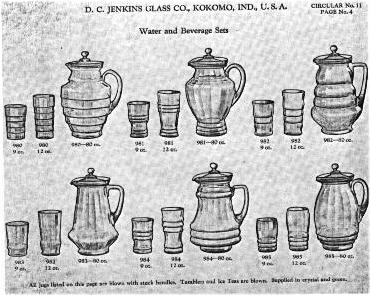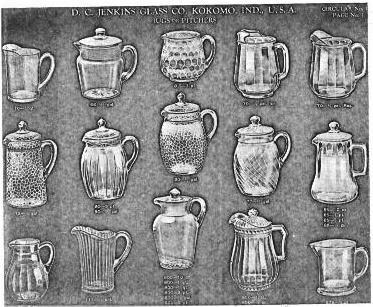National Depression Glass Association
Preserving America's Glass Manufacturing Heritage
D. C. Jenkins Glass Company
by Sandy Stout Olander
Rainbow Review Glass Journal - April 1972
The headline of 1901 in Kokomo,Indiana, read "One of the most
substantial and promising manufacturing industries that has found a
 home in Kokomo, Indiana since the discovery of gas in Indiana will
begin operation tomorrow Tuesday February 19, 1901. This new firm is
also solely owned and controlled by the Jenkins family, who were the
founders of the Indiana Tumbler and Goblet Works at Greentown. Many
collectors and dealers are familiar with the high value of any of the
Greentown Glass Co. items. Prior to the Jenkins involvement with the
Greentown Glass Works, D. C. Jenkins was hired by the United States
Glass Co. to start a new glass plant in Gas City, Indiana, whee he
stayed only a short time having been urged by his family to start the
Greentown plant operation.
home in Kokomo, Indiana since the discovery of gas in Indiana will
begin operation tomorrow Tuesday February 19, 1901. This new firm is
also solely owned and controlled by the Jenkins family, who were the
founders of the Indiana Tumbler and Goblet Works at Greentown. Many
collectors and dealers are familiar with the high value of any of the
Greentown Glass Co. items. Prior to the Jenkins involvement with the
Greentown Glass Works, D. C. Jenkins was hired by the United States
Glass Co. to start a new glass plant in Gas City, Indiana, whee he
stayed only a short time having been urged by his family to start the
Greentown plant operation.
Mr. Jenkins came from a family of glass workers, and early in life, in 1866, started a glass plant at Findlay, Ohio, not moving on to the United States Glass Co. until 1893. By 1900 he had resigned as director of the National Glass Company and had managed the Greentown plant for one year. The D. C. Jenkins Glass Co. remained under his control until his death in 1930.
The D. C. Jenkins plant manufactured a line of pressed glassware, with tableware of all kinds receiving the principal attention. In the beginning, before expansion, the plant had the capacity to complete 13,000 dozen articles per week, employed 135 men and was incorporated for $350,000.
In the early years, the factory had eight shops, each shop being comprised of a pressing machine, with the men to operate it, gather the glass and transfer the manufactured article to the annealing oven. About six men were employed in a "shop", each "shop" producing a different type of article.
The manufacture of glass starts in the mixing room, located in the
basement, into which the raw material is unloaded directly from
 boxcars. From there, the batch was taken to the elevator to the filling
in end of a continuous tank. The tank is of general acceptable
construction, but was the first of its kind to e used in the West. No
pots are used in this plant, all the glassware being "tank" glass and
that, by the way, is what depression glassware is - "tank" glassware,
not "pot" glassware. At the working end of the tank, presses are set
and the glass is gathered, then it is taken to the molds, each machine
being provided with a different pattern, where it is pressed into form.
Then it is carried to one of the big annealing lehrs, through which it
passes to the selectors and packers ready for shipment to the jobbers.
The culling and packing was done largely by after school teenagers.
There they sort out 1000 barrels a week or more.
boxcars. From there, the batch was taken to the elevator to the filling
in end of a continuous tank. The tank is of general acceptable
construction, but was the first of its kind to e used in the West. No
pots are used in this plant, all the glassware being "tank" glass and
that, by the way, is what depression glassware is - "tank" glassware,
not "pot" glassware. At the working end of the tank, presses are set
and the glass is gathered, then it is taken to the molds, each machine
being provided with a different pattern, where it is pressed into form.
Then it is carried to one of the big annealing lehrs, through which it
passes to the selectors and packers ready for shipment to the jobbers.
The culling and packing was done largely by after school teenagers.
There they sort out 1000 barrels a week or more.
Many companies obtained moulds from those who made only molds for
the overall glass trade, however, the D. C. Jenkins plant employed its
own mould shop right inside the glass plant, and was at the time known
for having the most complete mould and machine shop in the country.
The moulds account for the greatest expense in glass manufacturing.
Styles change in glassware for table use quite as frequently as in
millinery. A mould, from the drawing of the design to the time of its
completion in the foundry costs approximately $500 and may take as
long as a few months to a year in the making. For machine made
 glassware, 16 of these moulds are used on one machine which rotates,
and for handmade glassware, 8 moulds are used. Each mould may cost from
$300 to $500 apiece, times the 8 or 16, so you can readily understand
why moulds are reactivated or brought out by another glass firm when
they are no longer useful to the owner of the moulds.
glassware, 16 of these moulds are used on one machine which rotates,
and for handmade glassware, 8 moulds are used. Each mould may cost from
$300 to $500 apiece, times the 8 or 16, so you can readily understand
why moulds are reactivated or brought out by another glass firm when
they are no longer useful to the owner of the moulds.
The making of the patterns and the chipping out of the fancy designs in the polished iron requires high skill and an artistic sense, as well as the knowledge of the trained machinist.
The company did not limit its line to tableware. They also made lanterns, candy containers, fruit and fish globes, lamp founts, display jars, private mould work and glass novelties.
The Jenkins Glass Company issued patterns in pink, green, crystal and iridescent marigold. Marigold was the only iridescent color issued and was not done at the Jenkins plant, however, the blanks were made there and decorated elsewhere, then brought back to the Jenkins plant. In many of your depression patterns which also came in marigold, you can attribute to Jenkins. They made a great amount of fountainware and hotelware, these being heavier than the tableware lines.
D. C. Jenkins issued what is referred to today as pattern glass as well as depression glass. Some of their moulds, or most of their moulds, have been purchased by other companies which are using them today. One such pattern is Panelled Grape. Indiana Glass Company and the L. E. Smith Glass Company purchased some of the moulds which they have used recently in their dinnerware lines. One which belongs to Indiana at present is the tray that the diamond shaped sugar and creamer sits on. It is an original Jenkins product.